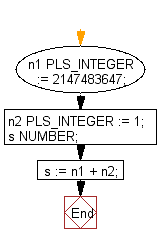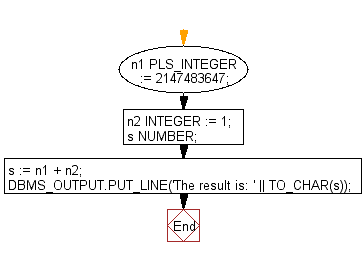PL/SQL DataType: Program to show the upper limit of PLS_INTEGER
PL/SQL DataType: Exercise-5 with Solution
Write a PL/SQL program to show the upper limit of PLS_INTEGER.
Sample Solution:
PL/SQL Code:
DECLARE
n1 PLS_INTEGER := 2147483647;
n2 PLS_INTEGER := 1;
s NUMBER;
BEGIN
s := n1 + n2;
END;
/
Sample Output:
DECLARE * ERROR at line 1: ORA-01426: numeric overflow ORA-06512: at line 6
Flowchart:

The range of the PLS_INTEGER datatype is -2,147,483,648 through 2,147,483,647. In the expression s:= n1 + n2, exceded the upper limit.
A calculation with two PLS_INTEGER values overflows the PLS_INTEGER range and an overflow exception error message will appear, even if the result assign to a NUMBER data type.
To prevent the exception overflow use integer for calculations outside the PLS_INTEGER range. Here is the example:
DECLARE
n1 PLS_INTEGER := 2147483647;
n2 INTEGER := 1;
s NUMBER;
BEGIN
s := n1 + n2;
DBMS_OUTPUT.PUT_LINE('The result is: ' || TO_CHAR(s));
END;
/
Sample Output:
The result is: 2147483648 PL/SQL procedure successfully completed.
Flowchart:

Go to:
PREV : Write a PL/SQL procedure to accepts a BOOLEAN parameter and uses a CASE statement to print Unknown if the value of the parameter is NULL, Yes if it is TRUE, and No if it is FALSE.
NEXT : Write a PL/SQL program to show the uses of SIMPLE_INTEGER datatype.
Improve this sample solution and post your code through Disqus
What is the difficulty level of this exercise?
